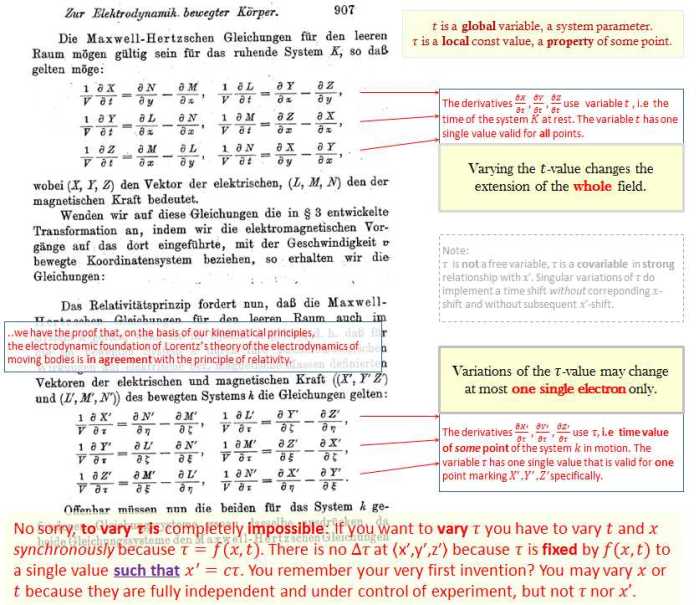The universities of Germany which are publicly financed are not even better performing when dealing with Einstein’s theories than others or of other countries. They fall into the Einsteinian traps by the dozen. Note the following fact:
I didn’t find some active teacher of a German high school or active lecturer of a German university that is critical about Einstein’s ideas and to state this publicly.
(Einstein’s ideas may not be called theories as they deal with objects existing in Einstein’s imagination only). This might be important for anyone interested in science: In reality we are caught and we are guided by two principles that seem to act like Pauli’s principle, but these are far more fundamental:
- In reality there is one fact at any place.
- In reality there only is allowed to persist what does not eliminate each other.
Any physical position may be occupied only once at at time: The house you live is not public space. In the opera seats are occupied or not and if so only once. Where your car is parked no other may be dropped. On hard disks any cell is magnetized or not. Hence, we don’t have to agree all the time about everything, about anything that is happening, did happen or even not. The facts will give the answer as long as the facts are clearly to be taken. The objects itself we are dealing with in reality enforce the concensus about their existence and properties. This is a quite useful property. We are allowed to state “the time will show” and take notice of this soothing and relaxing effect of our common reality.
Objects that exist in other peoples mind are hidden to us. Whether they do exist or not, whether they exist doubled or only on Mondays, this is hidden to all others that don’t have access to this particular piece of hardware. Therefore, in order to enable fruitful discussions and scientific dialogues with some benefit there must be established some procedure to give precise depictions of the objects created by mind. This seems to be the very basic error when dealing with Einstein’s ideas:
We imagine being able to understand what Mr. Einstein did pretend to have in mind.
As long as his stories are trivial (“the house is high”, “the nose is red”) they do not matter. If they are baffling like the story about the travelling twin that will return to be younger than his twin brother, he might be sure to get our attention. Our quite simple question “why he is younger then?” is answered by dozens of experts paid by the tax payers around the globe.
- How do these wise men gain certainty to give the true answer (which may be given only [by using the principle of uniqueness in reality] as of to be Mr. Einstein himself who invented the clock paradox)?
- How do they ensure that the ideas of a single man do carry scientific significance (Just compare that with Mark Twain‘s or Gene Roddenberry’s ideas that are not subject to science.)
Based on the facts: The experts cannot have any certainty as they cannot know what Einstein had in mind. They have models, calculations or diagrams to explain the ideas but they don’t have the fact that
- the ideas have scientific significance or
- the ideas are the Einsteinian ones and not that of Minkowski, Epstein or their own.
What does it mean to understand?
Verstehen ist die intellektuelle Aufbereitung von Sachverhalten zum Zweck der Wiederverwendung des Erlernten als nützliches Wissen.
To understand is intellectual processing of issues in order to gain knowledge to be used like facts.
Now, Assume that the experts
- did manage to understand the clock paradox (twin paradox) and
- did manage to give their insights to the audience in a plausible way.
At this point we might have:
- The audience did understand and pick the explanation as their own knowledge to explain the effect. Hence the clarity gained might destroy their interests about the topic (as given for the Zonk-problem).
- If the audience did not understand how to become younger as traveler the riddle about the twin could persist.
The second case only gives the chance that the intellectual investments of the lecturers in theoretical physics retain their value. Now, this is where the trap gave a click.
This is the point where to understand that to understand a story changes the way we will understand the people that are telling it all the time.

The light clock was an Escher picture
- A proof that (c=const) is compatible with (covariance postulate) is still missing, Einstein’s try was flawed (he and Minkowski did show that one can draw a circle through any point and believed that this is physics).
PerfectNonsensV2 PerfectNonsense - The introduction of the Lorentz factor was the prime fallacy: Switching the time (to drive the speed) means to switch a vector, not just a scalar.
( The Light Clock was an Escher picture lightclockescher )The light clock example loses its shape just after switching the reference.
-
Nobody is able to get information that definitely nobody does have. Those who believe that Einstein was omniscient want to become like him. If they were successful they will fight until their retirement and promote Einstein to be the greatest scientist ever despite that they were told better:
HOW TO PROVE KASSNER TO BE OMNISCIENT?












